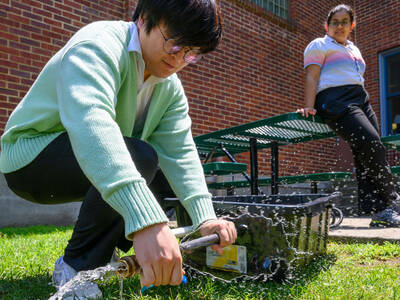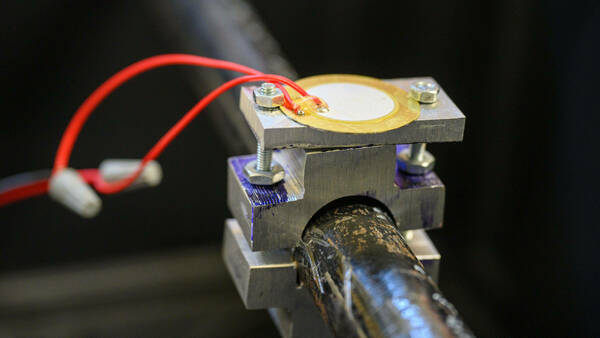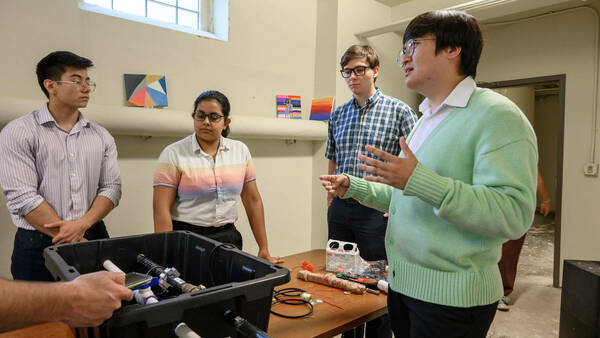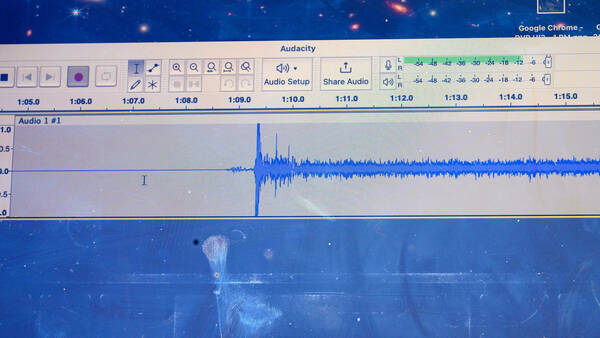
Notre Dame students working with city of South Bend, local firm on wireless monitoring technology
Drought conditions in the American Southwest have drained rivers and reservoirs and led to ongoing water shortages in places such as California and Arizona, highlighting the precarious nature of the nation’s drinking water supply and the need to protect and conserve what fresh water there is in the United States.
But even in places such as the Midwest, where access to fresh water is relatively abundant, leaky infrastructure threatens to limit supply as the Earth warms due to climate change, with implications for the environment and people’s pocketbooks.
According to the American Society of Civil Engineers, as many as 300,000 water mains break each year because of age or other factors, disrupting supply. The average water pipe in the U.S. is 45 years old. Some, dating from the turn of the 20th century, are still made of wood.
The problem is especially acute in northern states, where the regular freeze and thaw cycle puts additional stress on valves and pipes.
As a result, even the best-run public and private utilities lose about 15 percent of drinking water to leaks — and some as much as 50 percent — according to estimates, adding up to trillions of gallons of so-called “non-revenue” water each year.
But what if technology could prevent some of that loss and bring the number closer to zero?
That’s the question that Luis Montestruque and a group of University of Notre Dame students are trying to answer.
"It is very common to see a well-managed utility losing about 30 percent of water to non-revenue water, which is quite eye-opening. And that is a well- managed utility. I’ve seen utilities lose something on the order of 50 to 60 percent through leaks.”
Montestruque, a native of Peru who earned his doctorate in control system engineering from the University of Notre Dame, is co-founder of HydroDigital, a South Bend-based design consultancy that helps public and private utilities adopt digital technologies to transform how they manage water.
With support from the Notre Dame Center for Civic Innovation (CCI), part of the College of Engineering, and the city of South Bend, Montestruque is developing technology to detect water system leaks in real time, before they have a chance to expand, undermine critical infrastructure and disrupt service.
Leaks also increase operational costs, such as treatment and pumping costs, which get passed on to consumers, and contribute to the rising environmental impact of the nation’s drinking water systems, which are very energy intensive.

“Roughly speaking, it is very common to see a well-managed utility losing about 30 percent of water to non-revenue water, which is quite eye-opening,” said Montestruque, who was born in South Bend while his father was studying physics at Notre Dame. “And that is a well- managed utility. I’ve seen utilities lose something on the order of 50 to 60 percent through leaks.”
As currently envisioned, the technology would rely on sensors mounted to the outsides of pipes to “listen” for leaks, which have a distinct sound. When a leak is detected, an alert is sent to a dashboard where water employees can see it and take action. The technology is not necessarily new. Montestruque, however, hopes to make it cheaper and more accessible.
South Bend, for its part, currently hires someone to walk its entire water system every two years and search for leaks manually with a stick microphone. Other utilities use similarly low-tech methods for detecting leaks.
Leveraging his connections and proximity to Notre Dame, and with support from iNDustry Labs, a University-wide platform for collaboration with local industry, Montestruque worked with a multidisciplinary group of students this past spring to validate the technology as part of Industry and Community-based Innovation Projects, a 1- to 3-credit course led by CCI director Jay Brockman, professor of the practice in the College of Engineering.
“They designed a system that is able to detect when an event is happening in a drinking water system … and (wirelessly) trigger an alert,” Montestruque said of the students.
Now, CCI summer interns are working to advance the technology even further in partnership with the city and its Department of Public Works, which provides clean drinking water to more than 112,000 customers across 550 miles of water pipes, equivalent to the distance between Chicago and Kansas City.
“Currently, South Bend loses around 365 million gallons of water a year to leaks, and the only process to detect leaks is the biannual survey where one person goes around for 500 miles of pipes listening for leaks,” Ishani Basak, one of the interns, said. “Our project is trying to automate that using an embedded system.”
By contrast, the city sells about 5 billion gallons of water per year, or about 13 million gallons per day, to customers both within and adjacent to the city proper. That’s enough to fill a quarter million backyard swimming pools.
The piezoelectric effect
The interns’ mission is two-fold: 1) document the current state of the city’s drinking water system; and 2) develop a working prototype of the leak-detection technology, including an algorithm to interpret the data collected by the sensors.
To that end, the interns recently toured a treatment plant along the St. Joseph River in South Bend along with a wellfield and pumping station on the city’s southwest side.
They’ve also been busy assembling and testing a prototype consisting of a so-called piezoelectric sensor and aluminum clamp, or mount.
About the size and shape of a silver dollar, the sensor measures vibration, which it converts to an electrical signal. The signal travels along a cord to an amp and then a laptop, where it appears as a wave.

This all takes place within a scale-model water system consisting of a set of pipes and valves suspended in a plastic tub and connected to a water hose.
Assembled from off-the-shelf parts and materials, the system allows the interns to control for a number of factors, including the presence and absence of leaks.
In this way, they can simulate real-world conditions and train the algorithm to recognize a leak based on its distinctive wave pattern — and in contrast to a “normal” wave pattern.
The mount acts as a conductor, transmitting sound from the pipe to the sensor, and provides for a flat surface on which to affix the sensor, which cannot otherwise bend or flex to fit the shape of the pipe.
Forming the backbone of the system, the piezoelectric sensor is a cheap and reliable form of technology, and thus easily scalable. A French physicist discovered the piezoelectric effect in the 1880s, and sensors designed to measure the effect have been around for decades. You can buy one for less than a dollar.
Eventually, the system will communicate wirelessly based on the so-called “internet of things.”
The interns are all rising juniors or seniors at Notre Dame. Basak is a mechanical engineering major with an aerospace concentration from Kolkata, India. Steven Conaway is a computer engineering major from Star, Idaho. Noah Sim is a computer science and history double major from Carmel, Indiana. Jonathan D’Alonzo is a computer science major from Saratoga Springs, New York.
“Water is getting more and more scarce, especially in the hottest two-thirds of states. So we’re hopeful that it works. But it’s at least worth trying because it’s something that hasn’t been advanced in a long time and something that should be advanced.”
The interns are currently working on a final prototype for the sensor mount, with an eye toward optimizing it to work seamlessly within an embedded system, consisting of both the hardware and software necessary to collect, transmit and analyze the sensor data within an entirely automated system.
“Our goal by the end of the project is we want to deliver a prototype sensor system and a prototype machine learning algorithm,” Sim said, adding, “We’re in the home stretch, essentially.”
According to Kieran Fahey, director of long-term control for the city of South Bend, South Bend loses 15 to 20 percent of its drinking water to leaks and, to a lesser extent, theft each year, which is about average for the industry. And while the city is in no danger of running low on water, “We still have a responsibility to keep costs as low as possible,” the Irish-born engineer said.
The interns will finish up with their work in early August, after which it will be up to Montestruque and HydroDigital to further advance and scale the technology, with South Bend set to serve as a critical testing ground for the technology.
Fahey, for one, is excited for the possibilities.
“It’s a very useful technology, especially with climate change,” said Fahey, who oversees the initiation and rollout of smart water technology in South Bend. “Water is getting more and more scarce, especially in the hottest two-thirds of states. So we’re hopeful that it works. But it’s at least worth trying because it’s something that hasn’t been advanced in a long time and something that should be advanced.”
Past experience
Montestruque is no stranger to South Bend, having worked with the city extensively in the past.
In 2004, he founded EmNet, a pioneering smart sewer company, in partnership with the city and Notre Dame, including the College of Engineering and the IDEA Center.
Based on technology developed with Michael Lemmon, professor of electrical engineering at Notre Dame, EmNet specialized in automated systems designed to redirect sewer flow during periods of heavy rain or snow melt so as to prevent so-called “combined sewer overflows,” which foul local waterways in violation of the Clean Water Act.
First deployed in South Bend, the technology saved the city about $500 million on a $700 million, EPA-mandated sewer project, thrusting both it and EmNet to the forefront of the smart sewer space. Former South Bend mayor and current Transportation Secretary Pete Buttigieg frequently touted the project during his 2020 presidential run.
“If we can replicate the success that we had on the (combined sewer overflow) problem on the drinking water side, I think that would be huge win for the city and the University.”
As a result, “South Bend has this reputation now in the water world as one of the most innovative utilities in the world,” Montestruque said. “So much so that through connections with the city I’ve been able to make contacts with utilities in the U.K. and Asia that are interested in the South Bend experience.”
EmNet was acquired by Xylem, a multibillion-dollar, global water technology company, for an undisclosed amount in 2018.
Montestruque subsequently served in multiple leadership roles with Xylem before striking out on his own with HydroDigital, wanting to work closer to the cutting edge of the smart water space and more directly with utilities.

According to Fahey, based on past experience, the city welcomed the opportunity to work with Montestruque and Notre Dame once again when it arose.
“When he approached us a few months back and said, ‘I have a new idea,’ we were all ears,” Fahey said.
Said Montestruque, “If we can replicate the success that we had on the (combined sewer overflow) problem on the drinking water side, I think that would be huge win for the city and the University.”
And, importantly, the environment too.
Part of the College of Engineering, CCI works with other research centers and individuals across Notre Dame to identify unique opportunities for collaboration around pressing civic and industry issues in the South Bend-Elkhart community.
For more information, visit civicinnovation.nd.edu.
Originally published by at news.nd.edu on August 03, 2023.